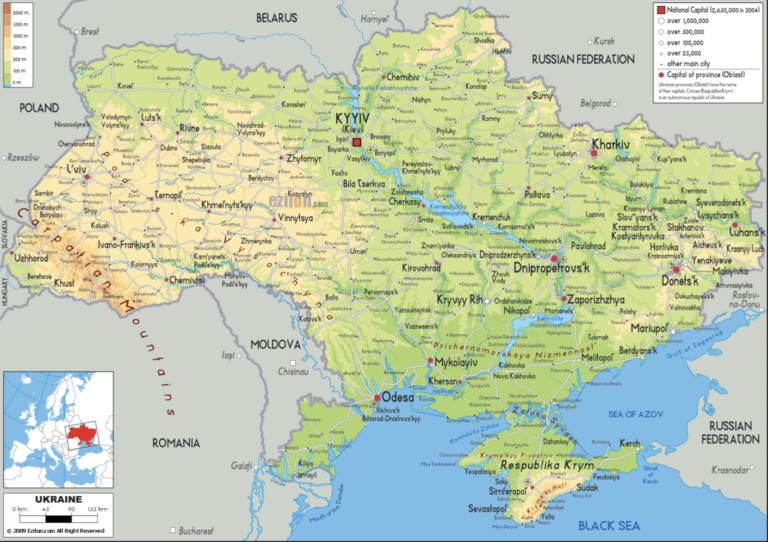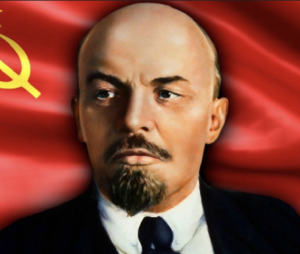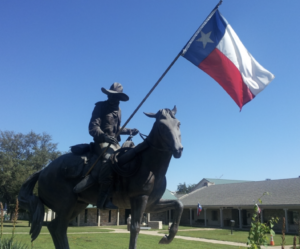BACKGROUND: WHY DID RUSSIA ATTACK UKRAINIAN “NAZIS”?
In the June 27, 2022 online issue of “National Review Plus Magazine,” an article by Mario Loyola carried the title “What is the Ukraine Endgame?” Loyola’s fundamental premise is that during the Soviet era, Moscow ceded too much of Russia’s own territory to Ukraine over the decades, including Crimea in 1954. So, when Ukraine declared its independence in 1991 inside borders that included the Donbas region, Crimea, and the prized Black Sea Fleet housed in Crimea, this situation remained untenable for Moscow. Now, “Ukraine’s nationalists finally have had to face the existential dilemma created by the country’s [enlarged] 1991 borders. They could have territorial integrity or political independence, but not both.”
In early 2014, Loyola continued, “Putin declared that it was necessary to ‘return Crimea to Russia’ as soon as possible. Weeks later, Russia engineered a separatist vote in Crimea and annexed the province. In eastern Ukraine, however, Russia pursued a different course. Instead of annexing the Donbas at the same time as Crimea, which it could easily have done, Russia insisted on the reintegration of the Donbas into Ukraine under Russian ‘protection.’ Indeed, this became Russia’s key demand in the internationally sponsored Minsk cease-fire agreements of 2014 and 2015. Thus did Russia’s responses to the events of 2014 develop along two azimuths, with very different objectives: the wresting of Crimea from Ukraine, and the preservation of the Donbas as an electoral foothold in Ukraine.
“Since 1991, some sort of compromise involving the status and borders of Ukraine has been the only realistic alternative to war. That compromise cannot be fully satisfactory, but it is the only way the conflict will end….
“Meanwhile, remarkably little attention has been given to how the conflict affects Americans, though the effects are plain enough in skyrocketing prices of food, gasoline, and electricity. Indeed, the war in Ukraine is causing such economic devastation around the world that poor countries such as Sri Lanka are suddenly on the brink of famine.”
As a retired U.S. Foreign Service Officer (diplomat) who has served at our Embassies in Moscow and Minsk, among several others, and who has spent much of my adult life studying Russia and the Former Soviet Union, this “National Review” online article rang true to me, especially with regard to the tension for Russia between accepting either Ukraine’s political independence or its sovereign borders. Very few in the Russian Federation’s leadership have likely ever wanted to accept either of those. I was the U.S. Embassy’s site officer in the Grand Kremlin Palace during President Bill Clinton’s state visit to Moscow in January 1994. The occasion was spent in trilateral negotiations between Russian President Boris Yeltsin, President Clinton, and Ukrainian President Leonid Kuchma to persuade Kuchma to return the nuclear weapons on his territory to Russia in exchange for security assurances.
President Kuchma was already obligated under the May 1992 Lisbon Protocol to the START Treaty to either destroy or return to Russia the strategic nuclear arms on his territory. In the trilateral negotiations with Yeltsin and Clinton, who were teaming up to obtain his commitment to do so, I believe Kuchma played a weak hand very well. In exchange for upholding Ukraine’s START Treaty obligations, Kuchma extracted security guarantees from both Russia and the U.S., obligating them in turn “to respect the independence and sovereignty and the existing borders of Ukraine;” as was later codified on December 5, 1994 in the Budapest Memorandums on Security Assurances. Kuchma, Yeltsin, Clinton, and UK Prime Minister John Major, as another one of the five recognized nuclear weapons states under the 1970 Nuclear Non-Proliferation Treaty (NPT), signed this document. The other two NPT-recognized nuclear weapons states, China and France, signed individual statements with Ukraine that contained these same assurances.
The Budapest Memorandums went on to state:
“2. The Russian Federation, the United Kingdom of Great Britain and Northern Ireland and the United States of America reaffirm their obligation to refrain from the threat or use of force against the territorial integrity or political independence of Ukraine, and that none of their weapons will ever be used against Ukraine except in self-defence or otherwise in accordance with the Charter of the United Nations;”.
While Russia has consistently interfered in Ukraine’s political and economic spheres since the end of the Soviet Union, that interference went to a much higher level in February 2014 when the Ukrainian Parliament and people successfully deposed President Yanukovich, a Russian puppet. Yanukovich fled to Moscow for asylum. Ukraine’s act of true political independence and freedom to define its own future proved too much for Russian President Vladimir Putin to bear. The Russians then illegally annexed Crimea and invaded Ukraine’s eastern provinces of Donetsk and Luhansk over the next two months, under bogus pretexts. More than 14,000 people have died in the Donbas (Don River Basin) region since then, as Ukrainian soldiers and Moscow-backed separatist forces have battled street-by-street against one another since then. That’s more than eight long years of what has devolved into a sort of urban trench warfare between city blocks in some cases along the shifting “Line of Control” in the Donbas region.
The Russians invented new spurious allegations against Ukraine over the past 10 or so months as their forces built up around Ukraine’s borders in advance of their eventual frontal attack on their sovereign neighbor. While their main pretext was to prevent Ukraine from the prospect of joining NATO, President Putin, Foreign Minister Sergei Lavrov, and other senior Russian officials began to claim that they needed to deal with the “fascists” and “neo-Nazis” now in charge of Ukraine. Such ridiculous claims would be laughable, if their effects were not so tragic for the people of Ukraine. President Volodymyr Zalenskyy is Jewish – hardly a Nazi – and his grandfather, like millions of other Ukrainians, fought side-by-side with the Russians against the German fascist forces. Few countries suffered more at the hands of Hitler’s forces than Ukraine did. That is, perhaps until today, as their Russian neighbors and historical cousins are reducing city after city in Ukraine to rubble.
We should not forget that since Russia invaded Ukraine on Feb. 24, 2022, the battle losses on both sides have been staggering. As the online UK “Express” reported on Friday, June 17, “According to Ukrainian figures, Zelenskyy’s forces have shot down 593 Russian unarmed aerial vehicles, 215 aircraft and 180 helicopters since the war began on February 24, 2022. They have also reportedly destroyed 1,122 tanks, 2,713 armoured vehicles and 509 artillery systems. Russian forces have also taken heavy human casualties. At least 25,100 Russian soldiers have been killed, according to Ukrainian estimates. The UK Ministry of Defence’s more conservative estimate puts Russian casualties at around 15,000 – the same number of soldiers that were killed in the Afghanistan war, which lasted for nine years.” The BBC reported on June 22 that the self-styled “People’s Republic of Donetsk” alone had lost 55% of its fighters to death or war wounds, which equates to some 11,000 men.
On June 27, the UK’s “Express” website provided updated numbers of Russian losses, as reported by the Ukrainian Centre for Strategic Communications and Information Security: “Russia’s military has lost 35,000 troops, 1,500 tanks and 217 planes in its war on Ukraine.”
The June 17 “Express” elaborated, “But Zelenskyy’s forces are also taking heavy losses, with a Ukrainian official estimating that up to 1,000 soldiers are being killed or wounded each day in the Donbas region of Ukraine alone.” Other Ukrainian officials have clarified that 100-200 of their soldiers are being killed outright each day.
Despite Russian forces wreaking devastation across Ukraine and committing atrocious war crimes against civilians since Day 1, thanks to Ukraine’s courageous and vigorous defensive operations, Russia had to quickly and severely dial back its initial objective to conquer all of Ukraine within 72 hours. Russian forces are now just trying to establish a permanent land bridge on Ukrainian territory from Russia’s border to the Crimean Peninsula, first by completely controlling the so-called Donetsk and Luhansk “People’s Republics.”
In order to complete the “land bridge” to the Crimean Peninsula, the Russians also need to be able to seize – and hold onto – a contiguous swath on the southern coastline of Ukraine along the Black Sea leading to the peninsula. This is why they have started such fierce, all-consuming battles for total control of the towns of Kharkiv in the northeast through Luhansk and Donetsk to Mariupol to Kherson and other towns in the south. The town of Severodonetsk in Luhansk Province finally fell to Russian troops on June 25. If Russia achieves this more modest goal, rather than total occupation, Putin also can be expected to try to conquer Ukraine’s last remaining port of Odesa further to the southwest from Crimea, thus leaving the country land-locked and economically ham-strung. Expect some of the bloodiest fighting, should that happen.
As of this moment, the war in Ukraine’s East has devolved into a large-scale artillery battle of attrition. As noted above, Ukrainian forces have successfully destroyed much of Russia’s high-end tanks and other equipment, but Russian artillery can keep pounding and destroying Ukrainian towns and villages endlessly, including firing from Russian territory. Ukraine does not have the necessary forces and weaponry to hold out forever against this unremitting onslaught. Recently, U.S. news broadcasters have begun to assert that Ukraine is now slowly losing the war, and many Western analysts are asserting that this war could “grind on” for many more months, if not years.
In the light of the Budapest Memorandum commitments alone, the Russian Federation’s perfidious, relentless warfighting against Ukraine over the past eight years is even more tragic. Fortunately, Ukraine’s geography lends itself to a relatively easy compromise solution, at least on paper, if and when both countries have had enough killing and economic suffering. And both countries could walk away from this diplomatic resolution with their heads held high.
Indeed, with some 12 million Ukrainian citizens displaced, or put another way, one third of the population made homeless by Russian forces’ callous, wanton destruction of their homes and surrounding civilian infrastructure, Ukraine’s domestic economy is in a corresponding shambles. Ukraine’s main exports: wheat and other crops, have been similarly decimated. The BBC reported on June 26 that, according to local farmers and a variety of other Ukrainian sources and drone videos, Russian forces have stolen over 800,000 tons of Ukrainian grain thus far. Drone videos have traced Russians purloining both grain from silos and transport trucks which have then been observed driving down to Crimea, and then crossing the rail/road bridge over the Kerch Strait into Russia proper. The grain was then mixed with Russian grain and off-loaded onto Russian ships for export around the globe.
This particular BBC report did not identify how much of Ukraine’s crops have simply been destroyed in the fighting, or how much land is lying fallow or unusable now with farmers unable to plant or tend new crops. This extreme devastation is reminiscent of Stalin’s forced collectivization of the peasants in Ukraine, Belarus and Western Russia from 1930 to 1935, when peasant farmers who did not quickly comply with his diktats were either shipped to Siberian gulags or forcibly starved to death. Author Robert Conquest’s pivotal work on this era, called “Harvest of Sorrow,” documented that some 17 million people were killed in that roughly five-year period across the tri-nation region which contains some of the world’s most fertile soil.
Even though the G7 on June 26 committed to support Ukraine “to the end,” and the EU has committed to help Ukraine rebuild its country one day, no matter how long the current warfighting continues, the population’s suffering and deprivations will likely continue for decades, from just these past four months of unrelenting conflict.
Further, the hardship is not Ukraine’s alone. People from Bangladesh to numerous other Asian and African countries as well could face severe food shortages and hunger from the loss of Ukrainian food imports, if not starvation themselves. COVID 19 sicknesses, COVID-induced supply-chain and other economic disruptions around the globe, along with ongoing localized conflicts had already set the stage for lasting economic peril in much of the developing world. But Putin’s war on Ukraine has unleashed a global whirlwind that includes increasing energy shortages and the likelihood of economic recessions in much of the developed world as well.
Rather than let Ukrainians continue to shed their blood and treasure while millions of others worldwide suffer the “second and third order effects” of the conflict, a way must be found to end the war that both sides can accept. I may have identified a possible diplomatic solution, and it’s one that could help two other warring parties in the Former Soviet Union as well. Stay tuned for Part II.




